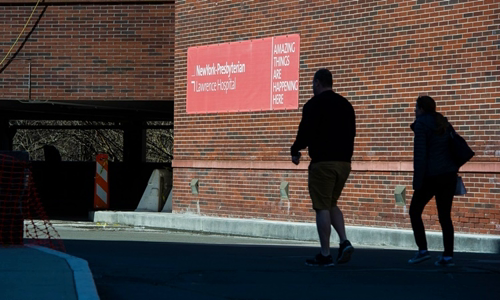US Lawyer Lawrence Garbuz, 50, finds it hard to breathe. After being taken to the hospital, the doctor suspected he had pneumonia and was taken to a normal room.
It was not until 4 days later, on March 2, it was discovered that he was getting weaker not because of pneumonia but from another cause: nCoV.

Outside New York-Presbyterian Lawrence Hospital in Bronxville Photo: NYTimes
Garbuz's case is the first sign that the virus is starting to spread in the community. Notably, Garbuz, from New Rochelle, New York, has never been to any of the Covid-19 hotspots in the world.
During 4 days at NewYork-Presbyterian Lawrence Hospital in Bronxville, Garbuz interacted with dozens of doctors and nurses, staff who brought food and made room for him, support staff to move him, and respiratory technician. , who is responsible for making sure his ventilator is working, and so does the other patient.
At least 8 hospital staff were tested, one positive for nCoV. Many others, including doctors, were quarantined, although the hospital did not disclose specific figures.
The New York government is seeking to reassure the public that the health system can cope well if the sudden increase in the number of patients with 1,200 beds is available. But many hospitals may face other shortcomings, such as health care workers with nCoV infection or isolation after contact with Covid-19 patients.
Patricia Edmund-Sealey from 1199 S.E.I.U, the union representing nurses, surgeons and other staff at Lawrence Hospital, said many people were worried they were infected with the virus. "A lot of people have come into contact with patients or patients' families," she said.
She described the situation at the hospital as a small script of what could happen across New York state, where 170 cases have been recorded, as of March 10.
Garbuz was given an X-ray shortly after being taken to Lawrence Hospital on February 27 with pneumonia-like symptoms. He was taken to a room on the fifth floor of the hospital but then transferred to another room. Initially, he can travel by himself. But when his breathing became worse, he informed the hospital and was given a wheelchair.
As his health continued to deteriorate, Garbuz was transferred to the intensive care unit on the third floor. With each move, he exposed more patients and hospital staff.
"A lot of people came in contact," a hospital employee was told to isolate himself. According to him, if Garbuz was determined to be infected with nCoV in the first place, the hospital would have put him in isolation and the medical staff would wear protective gear upon contact with him, thus, the spread would be reduced.
"He should have been taken to a negative pressure isolation room," the man said. "But he was only treated like a normal patient."
Over the past few months, as Covid-19 has spread to more than 120 countries, causing more than 120,000 people to be infected globally, New York hospitals have trained a number of staff in how to use effective protective gear and practice safety. Safe when treating patients. All of the above procedures come with a prerequisite that the hospital must quickly identify patients with the virus.
"We all focus on monitoring the front door, looking for people who have a cough, fever or have traveled abroad but what about the others?", Michael Phillips, epidemiologist at Langone University Hospital New York, ask questions. "I bet the flaw occurred when the patient was not immediately discovered."
He said in the past, many diseases, like the SARS in 2003, had spread through hospital transmission. "They come from undetected patients, hidden deep inside hospitals," he said.
According to Howard Markel, a professor of medical history at the University of Michigan, doctors and nurses must always treat patients who have not been diagnosed with cough and respiratory problems as potential risk patients. nCoV.
"We have to think of nCoV first," he stressed.
On the weekend of February 29, Garbuz received many visitors at Lawrence Hospital, mostly relatives. To date, at least three Garbuz family members and neighbors have taken him to the nCoV-positive hospital. The parking staff at the hospital are also worried.
"It's possible that we parked the victim's car," said Nilo Ismael Ramon, the parking officer.
During the weekend, Garuz's health deteriorated. He began to panic because of breathing difficulties. X-rays showed that his lungs were seriously damaged, a condition much worse than a few days ago. But apparently no doctor at the hospital thought of nCoV.
"For the doctors, Garbuz's travel history and exposure did not show the possibility of him getting nCoV," said a hospital employee who understood Garbuz's case.
On March 1, Garbuz was intubated and assisted with mechanical ventilation. Experts said intubation could increase the risk of nCoV infection for health-care workers in Garbuz's room.
In previous outbreaks of Covid-19, including SARS, many cases of virus transmission occurred in hospitals "through procedures such as intubation", Stephen Morse, professor of epidemiology at the School of Medicine Mailan Public Health at Columbia University, said.
Even with intensive treatment, Garbuz's condition did not improve. Doctors eventually decided to transfer him to Columbia University's New York-Presbyterian Medical Center in Manhattan.
Without any special precautions, he was taken to an ambulance on March 1. Two days later, New York Governor Andrew M. Cuomo announced a man from Westchester County, who had time to stay at nCoV-positive Lawrence Hospital.



 ImranBarlass
ImranBarlass







